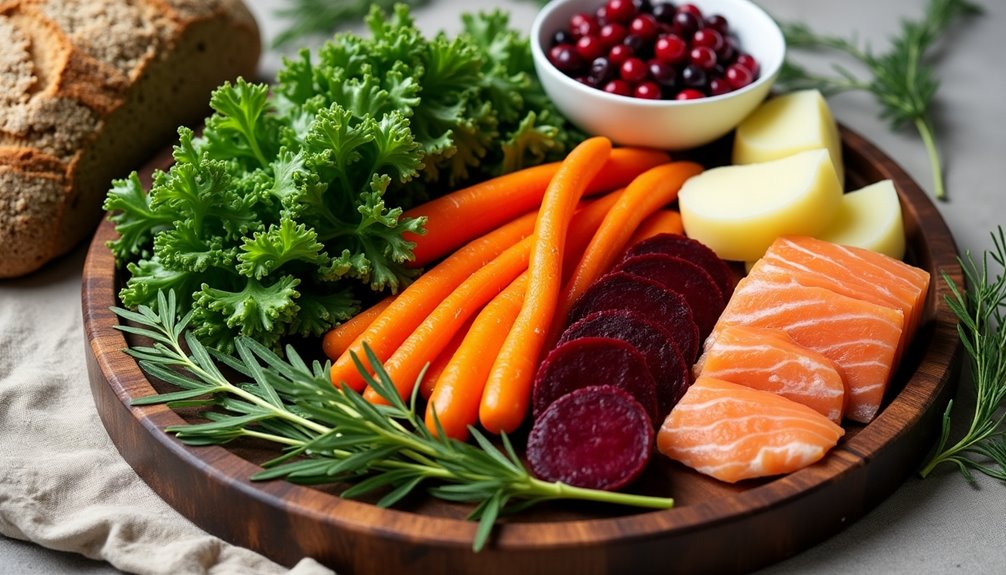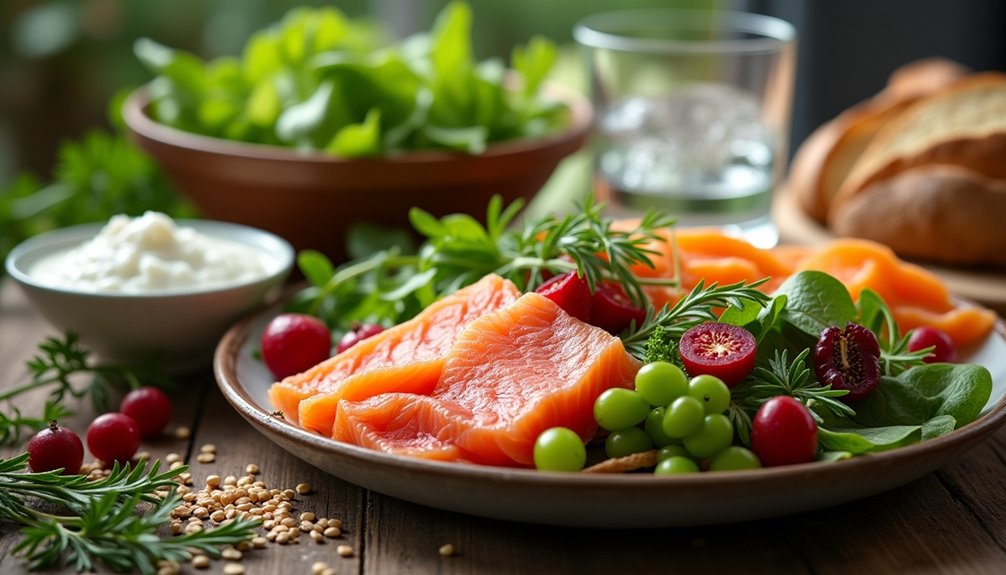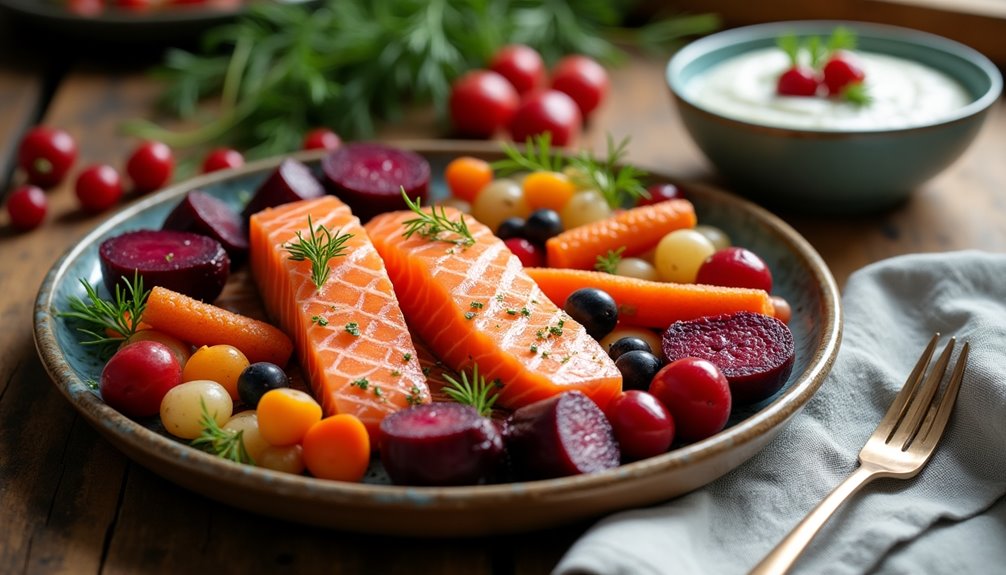The Nordic diet is a modern eating plan that prioritizes whole, unprocessed foods inspired by Scandinavian cuisine. You'll focus on nutrient-dense ingredients like fatty fish, root vegetables, whole grains, and berries. This diet supports heart health with healthy fats and omega-3 fatty acids, while also being rich in antioxidants and fiber. Not only does it aid in weight management, but it also reduces inflammation and improves overall well-being. Additionally, it encourages sustainable eating by using local, seasonal ingredients. If you're curious about meal planning and more ways to incorporate this diet into your life, there's plenty more to explore.
Key Takeaways
- The Nordic Diet focuses on whole, unprocessed foods like fatty fish, root vegetables, whole grains, and berries for optimal health benefits.
- It promotes heart health by emphasizing omega-3 fatty acids and healthy fats while being rich in antioxidants and fiber.
- This diet supports sustainable practices through local, seasonal ingredients, reducing climate impact, and promoting ethical sourcing.
- Meal planning encourages incorporating a variety of colors, herbs, spices, and fermented foods to enhance nutrition and flavor.
- Engaging with community resources, such as cooking classes and online groups, fosters connection and motivation in following the Nordic Diet.
What Is the Nordic Diet?

The Nordic diet is a modern eating plan inspired by the traditional cuisines of Scandinavian countries like Denmark, Norway, and Sweden. This diet emphasizes whole, unprocessed foods that aren't only nutritious but also culturally significant. By embracing traditional foods such as fish, root vegetables, whole grains, and berries, you can enjoy a variety of flavors while nourishing your body.
Cultural influences play an essential role in the Nordic diet. The traditions of these countries have shaped their food practices over generations, promoting sustainable and local eating. For instance, you'll find that fish, particularly herring and salmon, is a staple due to the region's rich maritime heritage. Root vegetables, like potatoes and turnips, thrive in the cold climate, making them vital to the local diet. Additionally, berries such as lingonberries and cloudberries are often foraged, showcasing the connection between food and nature.
As you explore the Nordic diet, you'll discover that it's not just about what you eat, but also about how you eat. This way of eating encourages meals shared with family and friends, fostering a sense of community and belonging. By incorporating these traditional foods into your daily life, you can celebrate the cultural influences that have shaped the Nordic way of living. Ultimately, the Nordic diet invites you to embrace not only a healthy lifestyle but also a rich cultural heritage. Furthermore, following a plant-based diet can also offer significant health benefits, including reducing the risk of heart disease and promoting overall well-being.
Key Components of the Diet

A key element of the Nordic diet lies in its emphasis on whole, seasonal foods that are both nutritious and flavorful. You'll find that this diet prioritizes traditional foods like whole grains, fatty fish, root vegetables, and berries. These ingredients not only reflect the local climate but also promote a sense of community, as they're often sourced from nearby farms or foraged in the wild.
Incorporating a variety of these foods helps you create balanced meals that nourish your body and satisfy your taste buds. For instance, you can enjoy a plate of rye bread topped with smoked salmon, accompanied by pickled vegetables and a side of hearty salad. This combination provides essential nutrients while celebrating the flavors of the region.
The Nordic diet also encourages the use of healthy fats, such as those found in canola oil and fatty fish, which contribute to both flavor and health benefits. By focusing on seasonal produce, you not only support local economies but also enjoy the freshest tastes of each season.
Don't forget about the significance of plant-based foods in this diet. Legumes, nuts, and seeds play a crucial role in creating balanced meals that are both satisfying and diverse. Additionally, adopting a diet rich in whole grains can help manage underlying health conditions like diabetes and high blood pressure, which are known contributors to chronic kidney disease. By embracing these traditional foods and seasonal ingredients, you'll not only enhance your cooking but also foster a deeper connection to the Nordic way of life, making meals an opportunity for togetherness and joy.
Health Benefits of the Nordic Diet

Numerous studies highlight the impressive health benefits of the Nordic diet, making it an appealing choice for those seeking a nutritious lifestyle. One significant advantage of this diet is its effectiveness in promoting weight loss. By focusing on whole foods like fruits, vegetables, whole grains, and fatty fish, you're more likely to consume fewer calories while still feeling satisfied. Research shows that individuals who adopt the Nordic diet often experience a reduction in body weight and body fat percentage, thanks to its emphasis on nutrient-dense foods.
In addition to helping with weight loss, the Nordic diet also supports heart health. The inclusion of omega-3 fatty acids from fish, along with healthy fats from nuts and seeds, contributes to lower cholesterol levels and reduced risk of heart disease. Studies have indicated that the Nordic diet can lead to significant improvements in various cardiovascular risk factors, such as blood pressure and triglycerides.
Moreover, the focus on seasonal and locally sourced foods increases the intake of antioxidants and essential nutrients, further enhancing overall health. By prioritizing these nutrient-rich foods, you not only nourish your body but also foster a sense of connection to your surroundings and the community. Additionally, programs like The Smoothie Diet(https://example.com) can complement the Nordic diet by providing a structured approach to weight loss and improved health.
Embracing the Nordic diet can lead to a healthier lifestyle, allowing you to enjoy delicious meals while reaping the benefits of weight loss and improved heart health. So, why not give it a try? You might find it's just the change you need to feel your best.
Sustainable Eating Practices

Sustainable eating practices increasingly resonate with those who want to make environmentally conscious choices while enjoying the benefits of the Nordic diet. By focusing on local, seasonal ingredients, you not only enhance the flavors of your meals but also reduce your climate impact. Eating what's in season and sourced nearby cuts down on transportation emissions and supports your local economy, fostering a sense of community.
Ethical sourcing is another crucial aspect of the Nordic diet. When you choose foods that are sustainably harvested, you contribute to responsible farming and fishing practices. Look for labels that indicate sustainable certification, which assures you that the food has been produced with respect for the environment and animal welfare. This not only benefits you but also helps preserve natural resources for future generations.
Incorporating sustainable practices into your daily meals can be rewarding. Simple actions, like opting for whole grains, legumes, and plant-based proteins, can notably reduce your carbon footprint. As studies show, plant-based diets significantly lower greenhouse gas emissions, further enhancing your commitment to sustainability.
Incorporating more vegetables and fruits also invites creativity into your cooking, allowing you to explore various flavors and textures while sticking to sustainable choices.
As you adopt these practices, you'll find that you're not just eating healthier; you're also becoming part of a larger movement toward environmental stewardship. By making informed choices, you align yourself with a community of like-minded individuals who value both health and sustainability. Embracing the Nordic diet can be a fulfilling way to nourish yourself while caring for the planet.
Tips for Starting the Nordic Diet

Starting the Nordic diet can be an exciting journey, especially if you frequently seek fresh, whole foods. This diet emphasizes seasonal produce, whole grains, and sustainable ingredients, making it not just a meal plan but a lifestyle choice. To help you get started, consider these practical tips:
- Meal Planning: Take time each week to plan your meals. Incorporate local, seasonal fruits and vegetables, whole grains like rye and barley, and healthy fats from sources like fish and nuts. This won't only save you time but also [guarantee] you're making nourishing choices. Emphasizing variety in meals will help keep your diet interesting and satisfying.
- Recipe Resources: Explore various recipe resources that focus on Nordic cuisine. Websites, cookbooks, and blogs dedicated to this diet can provide inspiration and ideas for your new meals. Look for recipes that highlight traditional ingredients while allowing for creativity in the kitchen.
- Join a Community: Connect with others who share your interest in the Nordic diet. Whether it's through social media groups, local classes, or cooking clubs, having a supportive community can enhance your experience and provide motivation.
Frequently Asked Questions
Can I Eat Dairy on the Nordic Diet?
You can include dairy in your diet, but it's worth exploring dairy alternatives too. Many find that options like almond, soy, or oat milk offer great nutritional benefits, like lower calories and added vitamins.
If you enjoy traditional dairy, go for options like yogurt or cheese in moderation. Balancing dairy with these alternatives can help you connect with others on similar dietary paths while ensuring you're getting a variety of nutrients.
Are There Any Specific Recipes for Nordic Diet Meals?
Imagine preparing a cozy dinner with friends, where traditional dishes bring everyone together. You can whip up hearty recipes like salmon with root vegetables or rye bread topped with herring.
For meal prep ideas, try making a big batch of beetroot salad or a warming stew; they'll keep well and taste even better the next day.
These meals not only nourish you but also create a sense of community around the table.
Is the Nordic Diet Suitable for Vegetarians?
Yes, the Nordic diet can be suitable for vegetarians. You can easily incorporate plant-based alternatives like legumes, nuts, and seeds to guarantee you get enough protein sources. Focus on seasonal vegetables and whole grains, which are central to this way of eating.
How Does the Nordic Diet Compare to the Mediterranean Diet?
When you compare the Mediterranean and Nordic diets, you'll notice distinct nutrition benefits and cultural differences.
The Mediterranean diet emphasizes healthy fats from olive oil and a variety of fruits and vegetables, promoting heart health.
In contrast, the Nordic diet focuses on whole grains, fatty fish, and root vegetables, enhancing omega-3 intake.
Both diets prioritize seasonal, local foods, but they reflect the unique culinary traditions and social practices of their respective cultures, fostering a sense of belonging.
Are There Any Restrictions on Alcohol Consumption?
When it comes to alcohol consumption, there're no strict restrictions, but following alcohol guidelines for health effects is crucial. Moderation is key; excessive drinking can lead to various health issues. Aim for a balanced approach that allows occasional enjoyment without compromising your well-being.
Conclusion
Incorporating the Nordic diet into your lifestyle can lead to impressive health benefits, with studies showing it may reduce the risk of heart disease by up to 30%. By focusing on whole foods, seasonal ingredients, and sustainable practices, you not only nourish your body but also support the environment. So, if you're looking for a way to enhance your well-being while being eco-conscious, the Nordic diet offers a delicious, healthful approach to eating.



